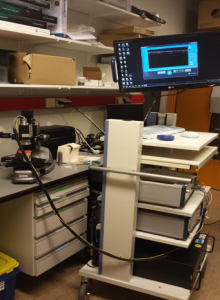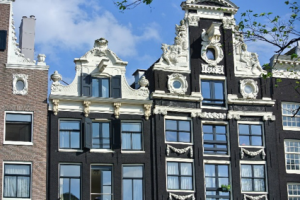 My name is Gabriela Diaz and I am a 3rd year student at Texas A&M University, Kingsville pursuing a Bachelor of Science in Chemical Engineering. My background in cultural heritage is a research experience (NSF-REU) at the University of North Texas studying X-ray fluorescence (XRF) to characterization 19th and 20th century silver-plated objects from the Dallas Museum of Art. I am here in Amsterdam through the Cultural Heritage Research in the Netherlands, an International Research Experience for Students (IRES) which is sponsored by the National Science Foundation (NSF).
My name is Gabriela Diaz and I am a 3rd year student at Texas A&M University, Kingsville pursuing a Bachelor of Science in Chemical Engineering. My background in cultural heritage is a research experience (NSF-REU) at the University of North Texas studying X-ray fluorescence (XRF) to characterization 19th and 20th century silver-plated objects from the Dallas Museum of Art. I am here in Amsterdam through the Cultural Heritage Research in the Netherlands, an International Research Experience for Students (IRES) which is sponsored by the National Science Foundation (NSF).
The focus of my summer research is a technique used primarily in the medical sciences but one that is rapidly gaining popularity in the art conservation community: optical coherence tomography (OCT). This reseach brings me to work most often in the Academic Medical Center under the mentorship of forensic biophysicist Dr. Maurice Aalders. However , since our primary aim is to use OCT at the Rijksmuseum, I also work with Katrien Keune in their atelier building. The technique operates on semi-transparent surfaces and is most famously used to understand the structure of the eye but has recently been applied in paintings conservation.
My research question explores how light penetrates the surface and stratigraphy of painting varnish layers. The chosen varnishes I will be working with will be dammar and mastic resin. Using OCT we measure the refractive index of different varnish recipes and also visualize how they appear within layering scenarios. We can also explore which situations give false positives and false negatives in order to take some of the guess work out of OCT analysis.
The Netherlands holds a special place in my heart due to the fact that one of my favorite painters is Johannes Vermeer. One of the theories behind his success is his prodigious use of optics—adapting the camera obscura—in order to “paint with light.” It is certainly a wonderful coincidence that I, too, shall be operating lenses and mirrors to tell a story—though my case is through an interferometer inside the OCT. Studying these methods of art conservation abroad yields the opportunity to gain new perspective on the styles and approaches scientists outside the U.S. take to restore a work of art. Being in the Netherlands also gives me a chance to get to know a bit about the culture of these world-renowned masters as well as admire their beautiful country.
 So far I have learned that no matter how well you think you understand something there will always be something unexpected to bring you back to the scientific chase. I never imagined finding myself studying methods to analyze art inside a hospital, and yet as the days pass it makes perfect sense that skills applied in preserving the health of an individual can find some application in preserving the health of a great painting. Everyday brings new questions and new things to image under the scan-head of the OCT. This constant curious thrill as well as the immersion in the energy of the city has made my transition from the states an adventure to remember.
So far I have learned that no matter how well you think you understand something there will always be something unexpected to bring you back to the scientific chase. I never imagined finding myself studying methods to analyze art inside a hospital, and yet as the days pass it makes perfect sense that skills applied in preserving the health of an individual can find some application in preserving the health of a great painting. Everyday brings new questions and new things to image under the scan-head of the OCT. This constant curious thrill as well as the immersion in the energy of the city has made my transition from the states an adventure to remember.
Master’s dissertation writing can be of great help when exploring the intersection between art and medicine in cultural heritage research. This unique field requires a deep understanding of both artistic expression and medical knowledge. A well-researched dissertation offers valuable insights, helping students analyze historical artifacts and medical practices, making the writing process more structured and enriching.
I find that using online platforms makes things much easier, especially when it comes to managing academic responsibilities. My experience with professional resource was exceptional, as their writing service essay provides reliable support for creating well-structured and meaningful documents. Among the services I found particularly helpful were the editing and custom essay writing assistance, which saved me valuable time during a busy semester.
Helping businesses not only with technical implementation but also with testing product ideas to validate their concept is essential for successful innovation. It ensures that every step is rooted in practicality and potential. My experience with Binary Studio was remarkable. They provided tailored solutions, excellent support, and a clear focus on delivering a product that aligns with market needs, making the entire process seamless and efficient.